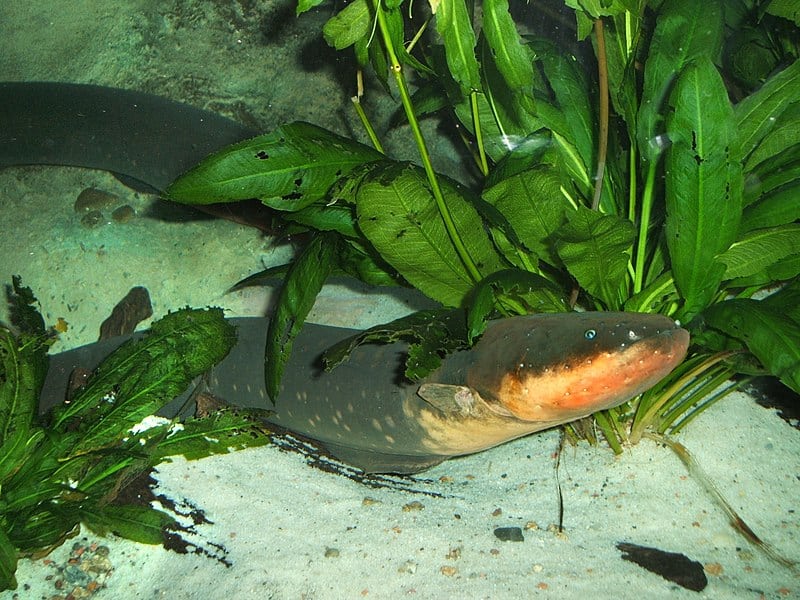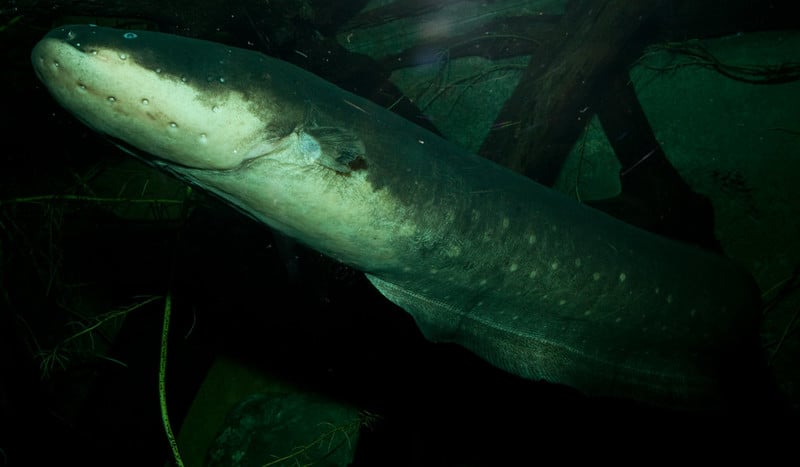Electric Eel Facts
- Perhaps the most notable fact about the amazing Electric Eel remains the simple fact that it does not actually represent a species of eel. In fact, the highly remarkable creature actually constitutes a particular variety of knife fish.
- Plus, this truly amazing creation of Nature also remains the only species in its genus. Presently, few specimens exist in captivity, since it remains difficult to catch. Its distinctive name does not completely mislead us in our image of such a creature.
- The wonder of Nature evolved a most shocking ability. Its astounding evolutionary path provided the fascinating fish with the ability to generate, and to discharge at will, electric currents. Quite surprisingly, these can measure as much as 600 volts.
- For the moment, the known population of the stunning Electric Eel appears to be both sufficient and stable, within its native habitat. The IUCN therefore presently lists the animal as Least Concern on its Red List of Threatened Species.
- The very nature and location of that endemic range, however, also serves to render it especially vulnerable to several threats. These factors, not surprisingly, consist of the dual dangers of habitat loss and the ongoing effects of climate change.
Related Articles



Electric Eel Physical Description
The amazing Electric Eel possesses a highly elongated shape completely in keeping with its kind. In fact, mature individuals average a body length of roughly 6.5 ft (2 m). In addition, fully grown individuals also attain an average weight of about 44 lb (20 kg).
Exceptional specimens of this remarkable species even reach 8 ft (2.4 m) in length. However, the species exhibits a marked degree of the characteristic of sexual dimorphism. In its case, the males attain a significantly greater length than the females of the species.
Its coloring typically presents a grayish brown on top, and orange or yellow on the underside. Further differentiating the genders of the awesome animal, females generally display a darker color on the abdomen. Unlike most fish, it does not possess scales.
This ever-startling marvel of evolution also evolved as an entirely air-breathing fish. Therefore, it must return to the surface every 10-12 minutes to breathe. The incredible array of marvelous adaptations displayed by this unique form of life do not end here, though.
As proof of the versatility and resourcefulness of Nature, this breathtaking creature evolved the ability to generate electric charges within its own body. The three electricity-generating organs of its elongated body occupy about 80% of the body length, though.
The Electric Eel also remains fully capable of varying the intensity of the electric discharge. These organs are comprised primarily of specialized electrolytes. In fact, its biological processes generate its electric current in the same manner as a man-made battery.
- Kingdom: Animalia
- Phylum: Chordata
- Class: Actinopterygii
- Order: Gymnotiformes
- Family: Gymnotidae
- Genus: Electrophoros
- Species: E. electricus
Electric Eel Distribution, Habitat, and Ecology
The incredible Electric Eel evolved as native to an extremely restricted habitat range. This tiny area consists solely of the Amazon Basin and the Orinoco Basin, in South America. It also currently remains unknown if the animal ever possessed a more extensive range.
For the moment, no evidence exists to suggest that it ever lived anywhere else. Even in this region, the fish inhabits only specific types of habitats. These areas of habitation mainly consist of various swamps, floodplains, small rivers and creeks, and coastal plains.
Mature individuals generally prefer to live in areas with an abundance of stagnant water or muddy bottoms. Also, within its limited territorial range, it ranks as a true apex predator. The very young feed mainly on small invertebrates, such as crabs and shrimp.
But, the larger adults mainly feed on such prey as fish, and even small mammals that stray too close to the water. These same individuals will also consume invertebrates opportunistically, since Nature created the animal as highly adaptable in nature.
The astonishingly impressive Electric Eel also remains well-known among researchers for its unusual mating practices. In the mating season, the male builds a nest, actually made from its own saliva. The female then lays as many as 3,000 eggs into this nest.
Quite notoriously among researchers, the young that hatch first frequently eat the other eggs in the nest. In this manner, these reduce the competition for food. Not surprisingly, adults remain highly aggressive, especially during breeding season.
Species Sharing Its Range



Check out our other articles on 5 Fabulous European Mammals, Harpy Eagle, Fly Geyser, Long-Finned Pilot Whale, Achrioptera manga, Loggerhead Sea Turtle, Sea Marigold, Fire Salamander












Has science yet found a way to synthetically produce the organ of an electric eel?
Hello Ernst,
Thank you for your question. The answer is yes and no. A device based on the same principle now exists, created in 2018, though there are some differences.
Hope that helps!
Sincerely,
OBP